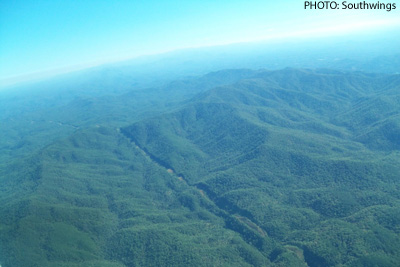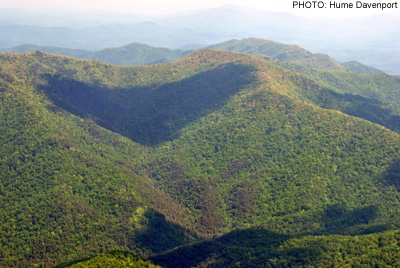Big Frog and Little Frog Wildernesses
By Laura Hodge
Some of Tennessee's most wild and beautiful areas are within the Cherokee National Forest, including the Big Frog and the Little Frog wildernesses. I know because I live nearby, in Coker Creek, Tennessee.
 |
The Big Frog Wilderness area's pinnacles and creeks encompass 8,082 acres, all but 89 of which can be found in southeastern Tennessee just a short drive from Chattanooga. Thirty-five miles of rough-hewn backcountry trails run through the wilderness, all rated “low-use” by the U.S. Forest Service except for a portion of the popular Benton MacKaye trail, named after the co-founder of The Wilderness Society, who championed the idea of balancing human needs with those of nature.
Because the trails are less traveled by visitors, secluded campsites offer privacy for backpackers, hunters, and fishers, and tunnels of rhododendron provide respite from the sun. Solitude here does not necessarily mean quiet, as the sound of exuberant streams can be mixed with that of gobbling turkeys, snorting wild boars, clattering timber rattlers, and, of course, the croaking frogs.
As one climbs from the lower altitudes toward the summit of Big Frog Mountain, Virginia pine gives way to a variety of hardwoods, including hickory trees. At 4,224 feet Big Frog is lower than its eastern cousins in the Smokies but still offers views into the adjacent Cohutta Wilderness in Georgia.
North of the Big Frog Wilderness and across the Ocoee River Gorge—which hosted the 1996 Olympic whitewater competition—lies the 4,666-acre Little Frog Wilderness. Low along the river and rising to 3,322 feet at Sassafras Knob, this second-growth forest blankets the horseshoe-shaped valley of Pressley Cove. Blooms of mountain laurel and iris mix among magnolia, dogwood, and redbud trees making spring an ideal time to visit
Unlike the Big Frog Wilderness, Little Frog features only one trail: Rock Creek Trail. Even so, it is as abundant with wildlife as its bigger sibling, with black bears, white-tailed deer, bobcats, and gray foxes roaming through its forest.
Because of the significance of the area as a migratory and breeding range for a number of species, particularly the golden-winged warbler, the Audubon Society includes it in the Southern Blue Ridge Important Bird Area, a designation that identifies for conservation certain areas that are vital for bird populations and biodiversity.
Tennessee Wild, in partnership with The Pew Charitable Trusts and other coalition members, has been advocating for the permanent protection of these landscapes.
Recently, the Senate Committee on Agriculture, Nutrition, and Forestry reported to the floor the Tennessee Wilderness Act, authored by Senator Lamar Alexander (R-TN). The legislation would safeguard nearly 20,000 acres of the Cherokee National Forest, including 348 acres of the Big Frog Wilderness and 978 acres of the Little Frog Wilderness.
 |
It would also create the first new wilderness in Tennessee in 25 years—the 9,038-acre Upper Bald River Wilderness—and add 9,204 protected acres to three other wildernesses, two of which are in northeastern Tennessee.
The U.S. Forest Service has recommended protection of the lands identified in the bill, which would safeguard some of the world's most biologically diverse temperate forest and extensive stands of old-growth hardwood.
In his testimony before the committee, Sen. Alexander submitted for the record a letter from dozens of recreation and outdoor business owners who support protecting land, wildlife, and clean water. We hope that the Senate will pass the Tennessee Wilderness Act soon and that Tennessee's House delegation will support these efforts to preserve the Big Frog and Little Frog Wilderness areas.
More information about the Tennessee Wilderness Act can be found at www.tnwild.org.
Laura Hodge is the Tennessee Wild campaign coordinator. She and her husband, Bill, a leader in the wilderness conservation community, live in Coker Creek, Tennessee, surrounded by the Cherokee National Forest, which they are working to protect.






